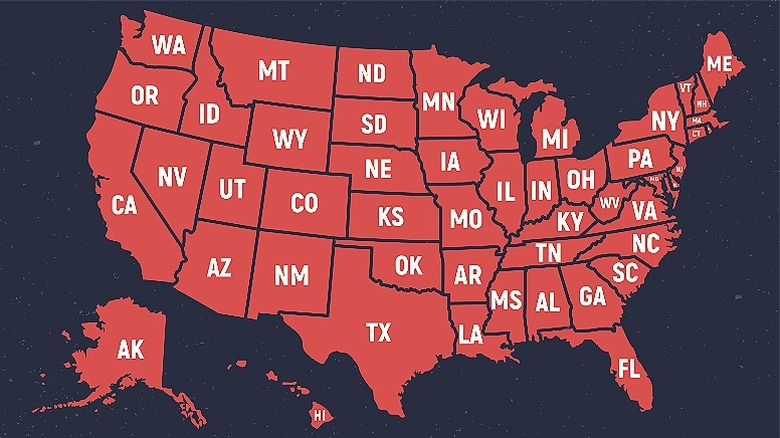Which States Have A Minimum Wage Of $15 Or More?
In the U.S., the federal minimum wage has been $7.25 per hour since 2009. Many states, however, have a minimum wage that's higher. As of September 2024, 30 states, plus the District of Columbia, have a minimum wage higher than $7.25, with seven states (along with Washington D.C.) having a baseline wage that's at least $15 per hour. Those states are California, Connecticut, Massachusetts, Maryland, New Jersey, New York, and Washington.
It should be noted that, with the exception of West Virginia, all 30 states with a minimum wage above $7.25 have a minimum wage that's at least $10; West Virginia's is currently $8.75. As for the other states, 13 have a minimum wage that's equal to the federal minimum wage, while Alabama, Louisiana, Mississippi, South Carolina, and Tennessee have no state minimum wage. Two states, Georgia and Wyoming, have a minimum wage that's below the federal limit, though employers covered by the Fair Labor Standards Act must pay workers the federal minimum wage of $7.25.
The states that pay at least $15 per hour
As noted in our intro, the District of Columbia, along with California, Connecticut, Massachusetts, Maryland, New Jersey, New York, and Washington, all pay a minimum wage of at least $15 per hour. However, in 2023, this group was actually a bit smaller, as Maryland and New Jersey only joined on January 1, 2024, when 22 states in total raised their minimum wage from the previous year. In 2023, Maryland's minimum wage was $13.25 and New Jersey's was $14.13. Here's a look at the changes 2024 brought to California, Connecticut, New York, and Washington as well. Massachusetts didn't change its minimum wage ($15), nor did Washington D.C., which is highest in the nation at $17.50.
- California: $15.50 to $16
- Connecticut: $15 to $15.69
- Massachusetts: $15 (no change)
- Maryland: $13.25 to $15
- New Jersey: $14.13 to $15.13
- New York: $14.20 to $15 (though NYC, Long Island, and Westchester went from $15 to $16)
- Washington: $15.74 to $16.28
- District of Columbia: $17.50 (no change)
In addition to these states with minimum wages of $15 per hour or more, there are six other states with a state minimum wage of at least $14 per hour: Hawaii ($14), Illinois ($14), Rhode Island ($14), Maine ($14.15), Arizona ($14.35), and Colorado ($14.42). (On that note, read more on the federal minimum wage versus state and local minimum wages.)
Efforts to increase the federal minimum wage
July 24, 2024, marked 15 years since the current federal minimum wage of $7.25 was established. When it was, it represented a 10.7% increase from the previous minimum wage of $6.55 per hour. A look at the history of the federal minimum wage under the Fair Labor Standards Act, dating back to 1938, this 15-year period (and counting) is by far the longest length of time the country's baseline wage hasn't budged.
The last longest stretch was between 1997 and 2007, when the federal minimum wage stayed at $5.15 per hour for 10 years; in 2007, Congress increased the minimum wage by 70 cents to $5.85. In fact, the Fair Minimum Wage Act of 2007 was what established the 2009 minimum wage of $7.25, which, again, is where it has been ever since. Recent efforts like the Raise the Wage Act of 2021 — which proposed gradually raising the federal minimum wage to $15 per hour — as well as the Raise the Wage Act of 2023 — which would raise the minimum wage to a living wage of $17 per hour — continue to be put forth, only to face significant hurdles. In 2021, for example, while the Raise the Wage Act passed the House of Representatives, the bill failed to get the votes in the Senate.
The Center for American Progress reports that raising the federal minimum wage to $15 per hour could impact nearly 40 million Americans. Until these efforts result in change, however, it's up to the states and municipalities to raise wages themselves.


